
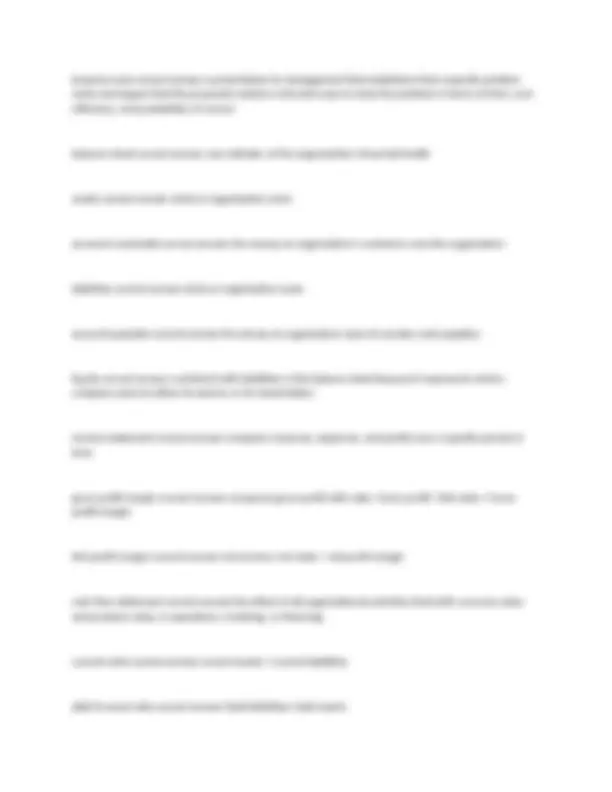
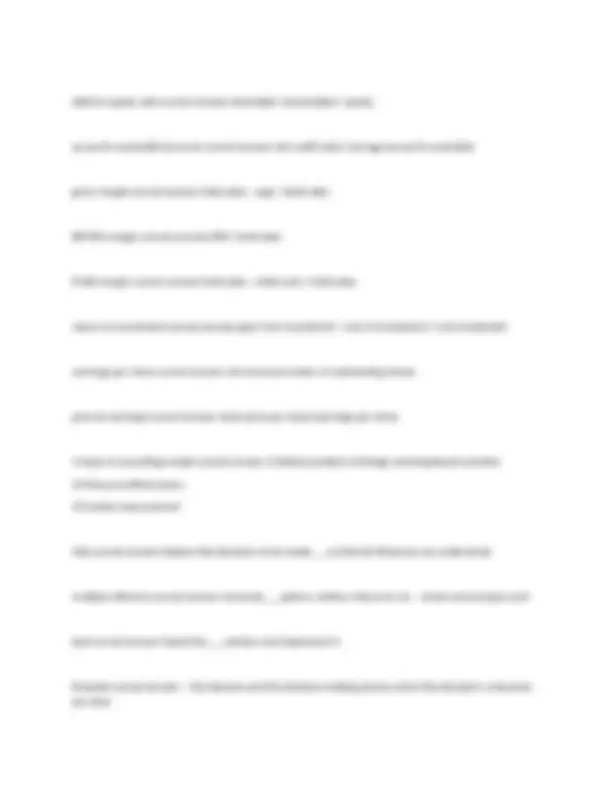
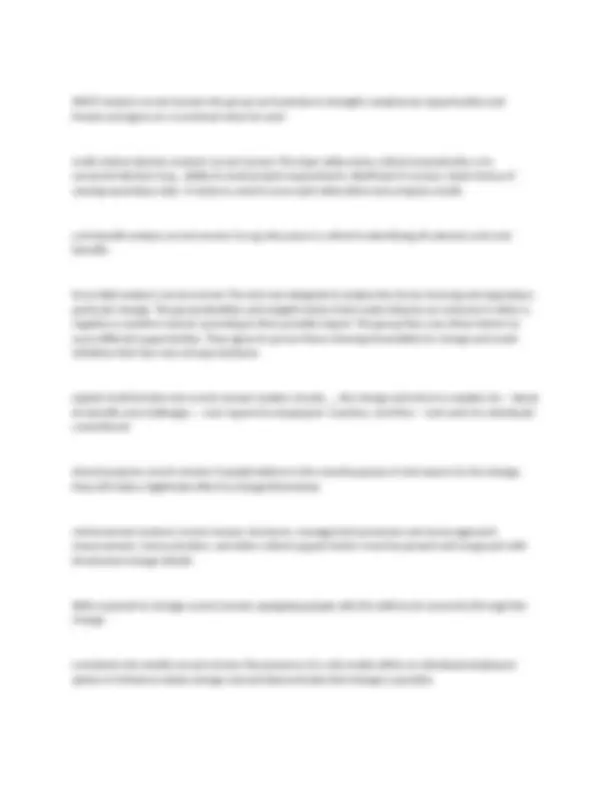
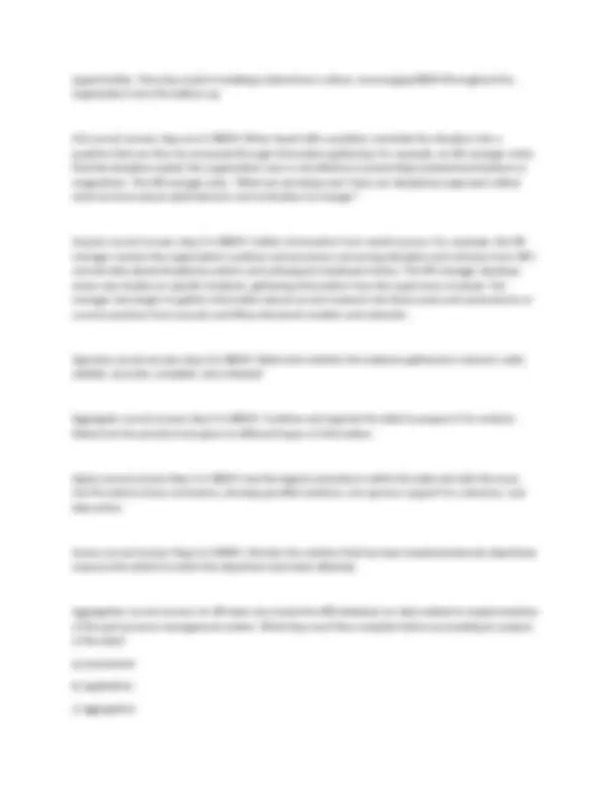
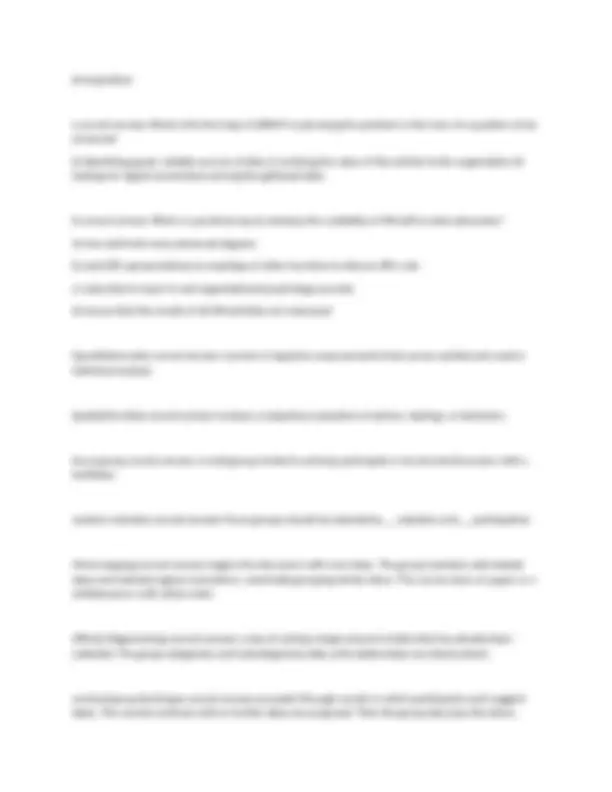
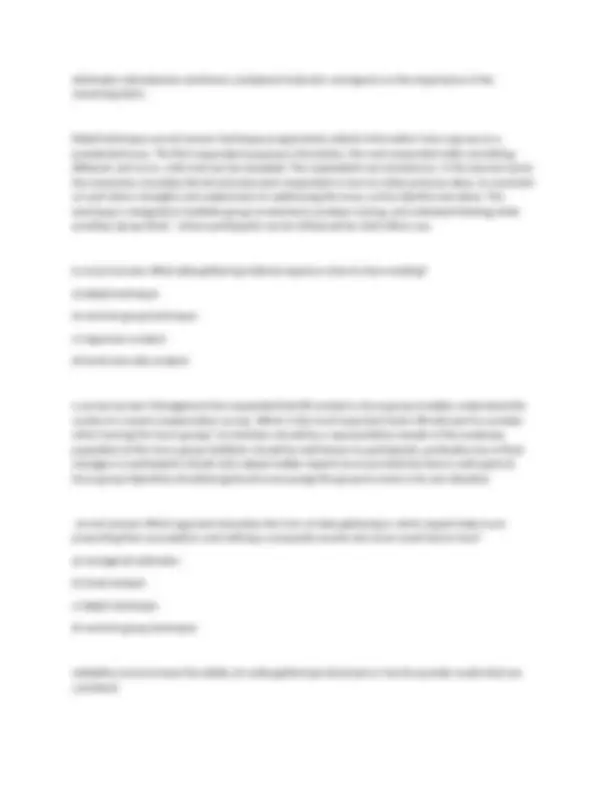
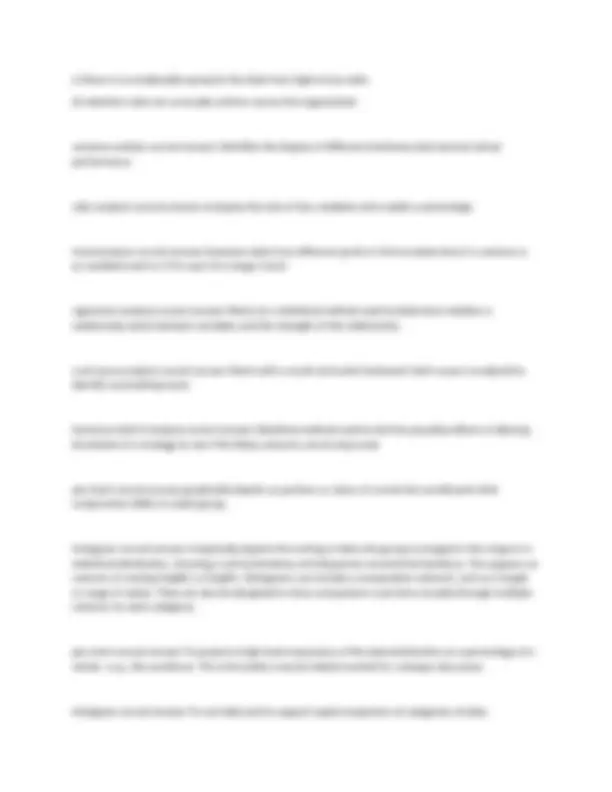
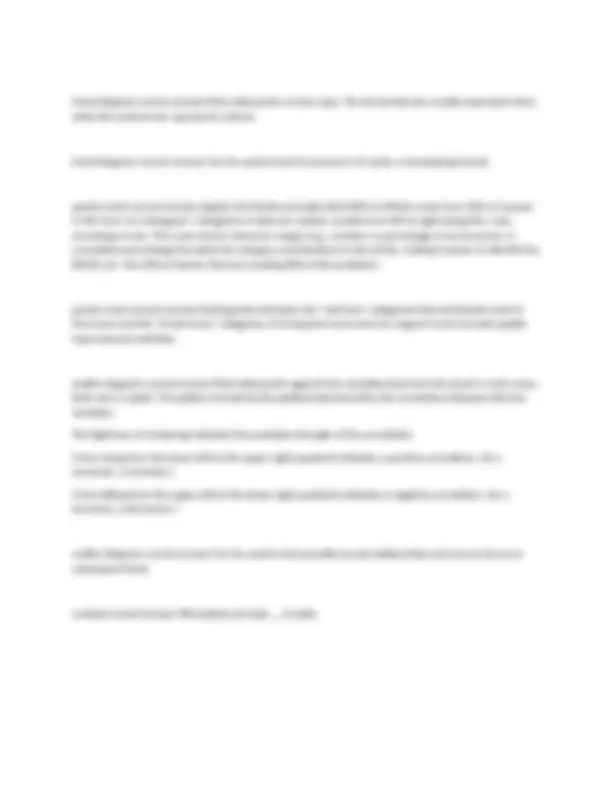


Study with the several resources on Docsity

Earn points by helping other students or get them with a premium plan


Prepare for your exams
Study with the several resources on Docsity

Earn points to download
Earn points by helping other students or get them with a premium plan
Community
Ask the community for help and clear up your study doubts
Discover the best universities in your country according to Docsity users
Free resources
Download our free guides on studying techniques, anxiety management strategies, and thesis advice from Docsity tutors
SHRM-CP Business Questions With Accurate Answers
Typology: Exams
1 / 14

This page cannot be seen from the preview
Don't miss anything!









Value correct answer defined and measured differently. Organizational success in meetings its strategic value chain correct answer represents the process by which an organization creates the product or service it offers to the customer Pivotal talent pool correct answer the key value that HR contributes to the value chain is the quality and availability of __ __ __ those employees whose skills are critical to the organization's strategy Multiple organizations correct answer A global value chain consists of -- -- producing parts of a good or service across geographical regions, with each link on the chain adding value Introduction correct answer 1st step of Life Cycle of Business: Revenue is low because there is little market awareness and because of the market's resistance to change. HR Goal is create. Growth correct answer 2nd step of life cycle of business; as time proceeds, revenue begins to increase; rate of growth will vary by industry; Goal: processes to max efficiency without stifling innovation Maturity correct answer 3rd step of business life cycle; Market: saturated with competitors and growth occurs only thru intro of new products or customer groups or acquisitions; narrower profit margins, important efficiency Renewal/ no growth decline correct answer demand decreases; company must renew by completely changing offerings OR take no action and accept continued low revenue OR take no action and accept fate Macroenvironment correct answer all factors that exist outside the organizations that could influence on organization's strategic decisions like industry and market conditions and events and trends in society
Business intelligence correct answer the ability to use information to gain a deeper understanding of an organization and its parts to see how the whole organization and its parts are performing and make sound business decisions that are grounded in relevant and accurate facts rather than assumptions Data gathering correct answer Data is routinely gathered through different computer system in all parts of the organization Data warehousing correct answer Data gathered from different systems is translated into a standard format and stored in databases related to specific uses. Enterprise resource planning correct answer suites of integreated applications for special purposes like finance resource management, supply chain management, human resource management, customer relationship management, manufacturing resource planning Query and reporting capabilities correct answer Users can access the data they need and use stand- alone or integrated business application software to sort, describe, and analyze data in myriad ways and to create report graphics. Online analytical processing correct answer takes data from the database and stores it in a compact, multidimensional cube. Organizes information incremental budgeting correct answer the previous year's budget is a starting point for the next year's budget and program and function leaders go from there zero-based budgeting correct answer previous year's budget is zeroed out and no funding commitments for the coming year are assumed activity-based budgeting correct answer the cost factors for specific activities are identified and used to estimate funding requirements. formula-based budgeting correct answer the total amount of a function's budget is apportioned to departments or activities according to defined percentages
debt to equity ratio correct answer total debt/ shareholders' equity accounts receivable turnover correct answer net credit sales/ average accounts receivable gross margin correct answer total sales - cogs / total sales EBITDA margin correct answer EBIT/ total sales Profit margin correct answer total sales - total costs / total sales return on investment correct answer gain from investment - cost of investment / cost investment earnings per share correct answer net income/number of outstanding shares price to earnings correct answer stock price per share/earnings per share 4 steps of consulting model correct answer 1) Define problem 2) Design and implement solution
SWOT analysis correct answer the group can brainstorm strengths weaknesses opportunities and threats and agree on a numerical value for each multi-criteria decision analysis correct answer The team determines critical characteristics of a successful decision (e.g., ability to meet project requirements, likelihood of success, least chance of causing secondary risks). A matrix is used to score each alternative and compare results. cost-benefit analysis correct answer Group discussion is critical to identifying all relevant costs and benefits. force-field analysis correct answer This tool was designed to analyze the forces favoring and opposing a particular change. The group identifies and weights factors that could influence an outcome in either a negative or positive manner according to their possible impact. The group then uses these factors to score different opportunities. They agree to pursue those showing favorability for change and avoid initiatives that face very strong resistance. explain truthful listen ask correct answer Leaders should __ the change and why it is needed, be -- about its benefits and challenges, -- and respond to employees' reactions, and then -- and work for individuals' commitment shared purpose correct answer if people believe in the overall purpose of and reason for the change, they will make a legitimate effort to change themselves. reinforcement systems correct answer structures, management processes and encouragement, measurement, communication, and other critical support factors must be present and congruent with the desired change initiativ Skills required for change correct answer equipping people with the skills to be successful through the change consistent role models correct answer the presence of a role model within an individual employee's sphere of influence makes change real and demonstrates that change is possible.
organic correct answer this method relies on independent centers and multiple origins of the change within the organization. Points of origin can be at any level. Organic change radiates out unevenly but accelerates when top leadership supports local change and leaders Sustaining the change in the organization correct answer What do the final stages of Kurt Lewin's and John Kotter's models of change management primarily focus on? b correct answer An organization has struggled to launch a new HR management system with higher integration and more functionality. The new user requirements are very different, and the beta test was problematic. The vendor fixed the problems, but the staff's nervousness about having to learn a new system has combined with the poor beta test experience to create resistance to bringing the final product online. Which actions should the HR manager take now to help to implement this initiative? a) Arrange a pre-launch celebration and invite all employees b) meet with the staff and the vendor to discuss issues c) revisit the project schedule to delay implementation until the issues are resolved d) request that the vendor simplify the system and user requirements Data advocacy correct answer developing an inquiring mindset, learning what data drives the business and where it can be found, developing partnerships across the organization to promote EBDM and modeling the skill of EBDM to the entire organization through the decisions HR makes and the plans of action it undertakes Data gathering correct answer knowing what constitutes sufficient, credible, and objective evidence and being able to find it data analysis correct answer being able to organize data so that it reveals patterns and to analyze i t to detect logical relationships EBDM correct answer being able to apply the results of data gathering and analysis to make better business decision Effective, informed EBDM correct answer -- data advocates show that analysis does not exist for the sake of analysis. It is focused on making more -- decisions that minimize risk and maximize
opportunities. They also assist in building a data-driven culture, encouraging EBDM throughout the organization from the bottom up. Ask correct answer step one in EBDM; When faced with a problem, translate the situation into a question that can then be answered through information gathering. For example, an HR manager notes that the discipline system the organization uses is not effective in preventing eventual terminations or resignations. The HR manager asks, "What are we doing now? Does our disciplinary approach reflect what we know about adult behavior and motivation to change?" Acquire correct answer step 2 in EBDM; Gather information from varied sources. For example, the HR manager reviews the organization's policies and processes concerning discipline and retrieves from HR's records data about disciplinary actions and subsequent employee history. The HR manager develops some case studies on specific incidents, gathering information from the supervisors involved. The manager also begins to gather information about current research into these areas and assessments of current practices from journals and HR professional societies and networks. Appraise correct answer step 3 in EBDM; Determine whether the evidence gathered is relevant, valid, reliable, accurate, complete, and unbiased. Aggregate correct answer step 4 in EBDM; Combine and organize the data to prepare it for analysis. Determine the priority to be given to different types of information. Apply correct answer Step 5 in EBDM; See the logical connections within the data and with the issue. Use the data to draw conclusions, develop possible solutions, win sponsor support for a decision, and take action. Assess correct answer Step 6 in EBDM; Monitor the solution that has been implemented and objectively measure the extent to which the objectives have been attained. Aggregation correct answer An HR team has mined the ERP database for data related to implementation of the performance management system. What step must they complete before proceeding to analysis of the data? a) assessment b) application c) aggregation
eliminates redundancies and items considered irrelevant, and agrees on the importance of the remaining items. Delphi technique correct answer technique progressively collects information from a group on a preselected issue. The first respondent proposes information, the next respondent adds something different, and so on, until a list can be compiled. The respondents are anonymous. In the second round, the researcher circulates the list and asks each respondent in turn to refine previous ideas, to comment on each idea's strengths and weaknesses for addressing the issue, and to identify new ideas. This technique is designed to facilitate group involvement, problem solving, and individual thinking while avoiding "group think," where participants can be influenced by what others say. b correct answer What data gathering method requires a face-to-face meeting? a) delphi technique b) nominal group technique c) regression analysis d) trend and ratio analysis a correct answer Management has requested that HR conduct a focus group to better understand the results of a recent compensation survey. Which is the most important factor HR will want to consider when forming the focus groups? a) members should be a representative sample of the employee population b) the focus group facilitator should be well-known to participants, preferably one of their managers c) participants should only subject matter experts to ensure that the time is well spent d) focus group objectives should be general to encourage the group to move in its own direction correct answer Which approach describes the form of data gathering in which experts take turns presenting their assumptions and refining a composite answer but never meet face to face? a) managerial estimates b) trend analysis c) delphi technique d) nominal group technique reliability correct answer the ability of a data-gathering instrument or tool to provide results that are consistent
validity correct answer the ability of an instrument to measure what it is intended to measure Sampling bias correct answer the sample doesn't represent the general population selection bias correct answer when participants are not randomly assigned to control and experimental groups or the researchers only choose to enroll certain types of participants response bias correct answer invites a representative sample, but the group that accepts or responds is not representative performance bias correct answer behave differently because they are being studied measurement bias correct answer raters are measuring incorrectly b correct answer HR seeks employee volunteers to compare two possible wellness programs. Their responses will be aggregated and analyzed to make a recommendation to senior management. How would you assess this critical analysis? a) the sample group is too small b) the sampling approach is flawed c) the program assessment tools cannot be validated d) the assessment tools the volunteers use will be unreliable a correct answer Which is the most important aspect of a selection test that successfully measures essential job-related skills and abilities? a) validity b) cultural compliance c) statistical significance d) reliability c correct answer Which feature should HR incorporate into a pre-employment test for a position that requires a high degree of accuracy, with any mistakes by the incumbent being dangerous?
c) there is a considerable spread in the data from high to low rates d) retention rates are unusually uniform across the organization variance analysis correct answer Identifies the degree of difference between planned and actual performance. ratio analysis correct answer compares the size of two variables and a yields a percentage trend analysis correct answer Examines data from different points in time to determine if a variance is an isolated event or if it is part of a longer trend. regression analysis correct answer Refers to a statistical method used to determine whether a relationship exists between variables and the strength of the relationship. root-cause analysis correct answer Starts with a result and works backward. Each cause is analyzed to identify a preceding cause. Scenario/what-if analysis correct answer Statistical method used to test the possible effects of altering the details of a strategy to see if the likely outcome can be improved. pie chart correct answer graphically depicts as portions or slices of a circle the constituents that compromise 100& of a data group. histogram correct answer Graphically depicts the sorting of data into groups arranged in the shape of a statistical distribution, showing a central tendency and dispersion around that tendency. This appears as columns of varying heights or lengths. Histograms can include a comparative referent, such as a target or range of values. They can also be designed to show comparisons over time (usually through multiple columns for each category). pie chart correct answer To present a high-level impression of the data distribution as a percentage of a whole—e.g., the workforce. This information may be helpful context for a deeper discussion histogram correct answer To sort data and to support rapid comparison of categories of data.
trend diagram correct answer Plots data points on two axes. The horizontal axis usually represents time, while the vertical axis represents volume. trend diagram correct answer Can be used to test for presence of cycles or developing trends. pareto chart correct answer Applies the Pareto principle (that 80% of effects come from 20% of causes) in the form of a histogram. Categories of data are ranked, usually from left to right along the x axis, according to size. The y axis shows reference ranges (e.g., number or percentage of occurrences). A cumulative percentage line plots the category contributions to the whole, making it easier to identify the 80/20 cut—the 20% of factors that are creating 80% of the problems. pareto chart correct answer Distinguishes between the "vital few" categories that contribute most of the issues and the "trivial many" categories of infrequent occurrence to support more-focused quality improvement activities. scatter diagram correct answer Plots data points against two variables that form the chart's x and y axes. Each axis is scaled. The pattern formed by the plotted data describes the correlation between the two variables: The tightness of clustering indicates the probable strength of the correlation. A line rising from the lower left to the upper right quadrant indicates a positive correlation. (As x increases, y increases.) A line falling from the upper left to the lower right quadrant indicates a negative correlation. (As x increases, y decreases.) scatter diagram correct answer Can be used to test possible causal relationships and narrow focus on subsequent tests. context correct answer HR analytics provide __ to data.